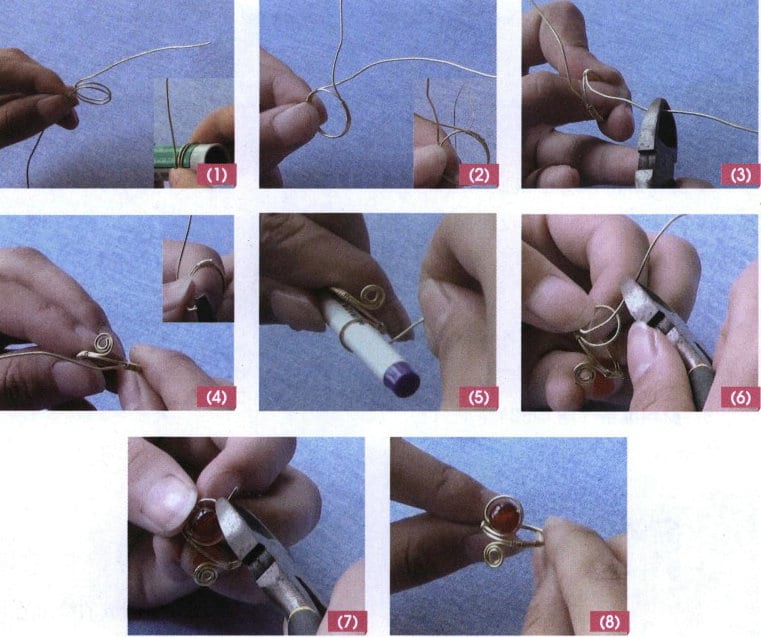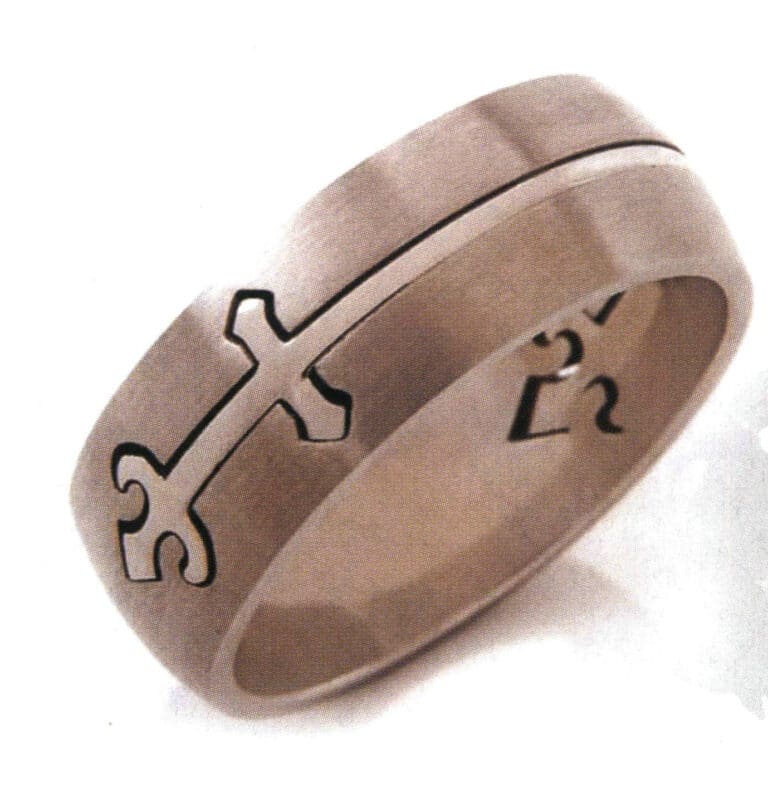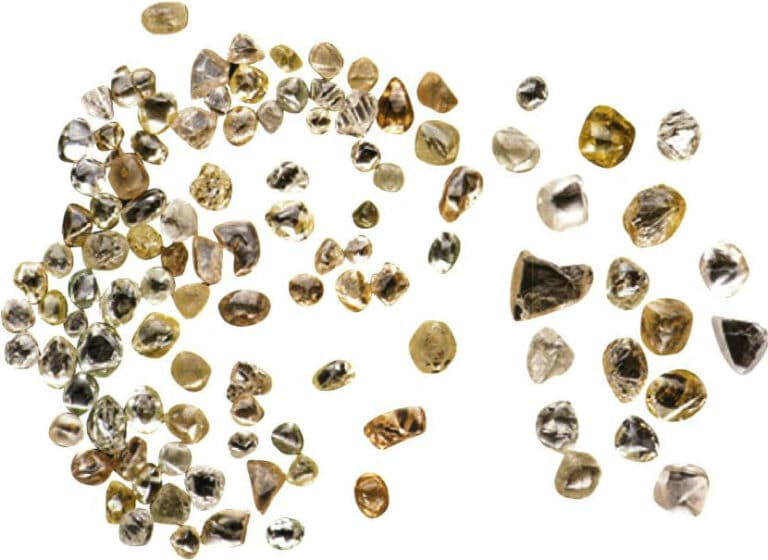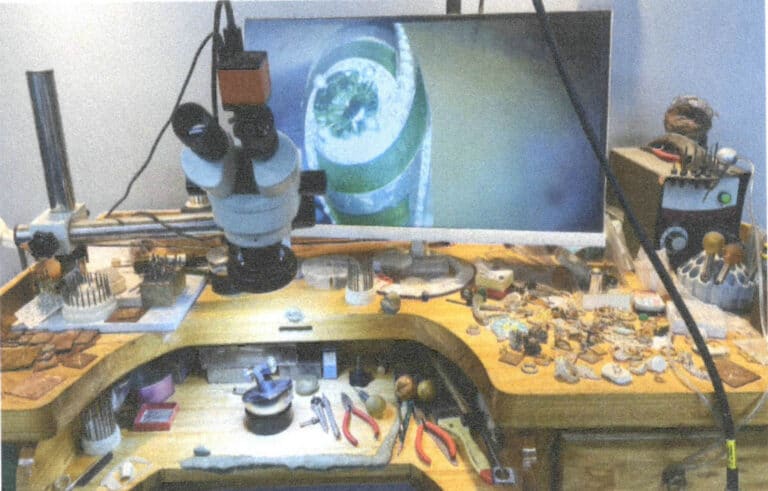Como desenhar e fazer lindas pulseiras e anéis: Um guia pormenorizado?
Designs de pulseiras e anéis artesanais: Guia passo-a-passo para fabricantes de jóias
Introdução:
Quer saber como criar peças de joalharia deslumbrantes? Este guia explora o mundo do design de braceletes e anéis, oferecendo instruções passo a passo para vários estilos. Aprenda a criar intrincadas pulseiras com nós e entrançados, designs com contas e detalhes em metal. Descubra como fazer anéis únicos com diferentes materiais e técnicas. Quer seja um fabricante de jóias, designer ou esteja à procura de peças personalizadas, este guia tem tudo o que precisa para criar belas jóias.

Design drawing of the crimson jade dream ring
Índice
Secção I Conceção e produção de braceletes
1. Design e produção de pulseiras de nós e tranças
1.1 Pulseira com nó de botão (dois estilos)
(1) Caraterísticas de estilo
Esta pulseira baseia-se principalmente no nó de botão tradicional. O estilo um combina o nó de botão com um nó de trança e um sino; o estilo dois trata o nó de botão como uma "conta", combinando-o com vários fios para criar uma combinação de nós de botão (equivalente à combinação de linha e "conta"). A decoração do nó é clássica, bonita, viva e generosa, como mostra a Figura 4-1.

(2) Principais pontos de aprendizagem
Aprender o método de tecelagem dos nós de botão e as combinações e aplicações dos nós de botão.
(3) Preparação do primeiro material
Fio cor-de-rosa: 25 mm (diâmetro) × 90 cm (comprimento), uma peça;
Sino: 25 mm (comprimento) × 20 cm (largura), uma peça;
Anel de salto: 6 mm, uma peça
(4) Preparação do segundo material
Fio vermelho: 25 mm (diâmetro) × 90 cm (comprimento), uma peça;
Conta de madeira: 10 mm, uma peça
(5) Método para fazer a primeira pulseira
Dobrar o fio cor-de-rosa ao meio para encontrar o centro, primeiro entrançar dois fios de 7~8cm, depois dar um nó de botão, ver Figura 4-2(1).
② É efectuado um total de 4 nós de botão, cada nó com um espaçamento de cerca de 0,8 cm; ver Figura 4-2(2).
③ Continue a entrançar dois fios, faça um nó de botão no final, corte o excesso de fio e derreta as pontas para unir. Preste atenção para distribuir uniformemente a distância entre os dois fios e o nó de botão para garantir a simetria; veja a Figura 4-2(3).
④ Utilizar uma argola para ligar um sino e depois pendurá-lo no centro do nó de botão como decoração; o efeito final é mostrado na Figura 4-2(4).

(6) Método para fazer a segunda pulseira
① Reservar a argola da casa de botão de acordo com o tamanho das pérolas de madeira e usar fio vermelho para tecer dois nós duplos, definindo o fio de tecelagem como a e b. Inserir uma linha c (linha adicional) no nó de ligação dupla, derreter e fixá-la; ver Figura 4-3 (1).
② Tecer um nó de botão separadamente nas linhas a e b e fixar estas duas linhas com um nó duplo; ver Figura 4-3 (2).
③ Dê dois nós de botão na linha c, dê um nó de botão na linha b e prenda as linhas b e c com um nó duplo. Ver Figura 4-3 (3).
④ Tecer dois nós de botão na linha a e um nó de botão em cada uma das linhas b e c. Depois de entrançar dois nós de ligação dupla para os fixar, cortar uma linha e fazer um fusível para a fixar, ver Figura 4-3 (4).
⑤ Utilizar uma linha para passar através do botão e, em seguida, fazer um nó com outra linha para o fixar e polir a linha para a fundir, ver Fig. 4-3 (5).
⑥ Ajuste a posição de cada nó de botão para criar um arranjo bonito, consulte a Figura 4-3 (6).
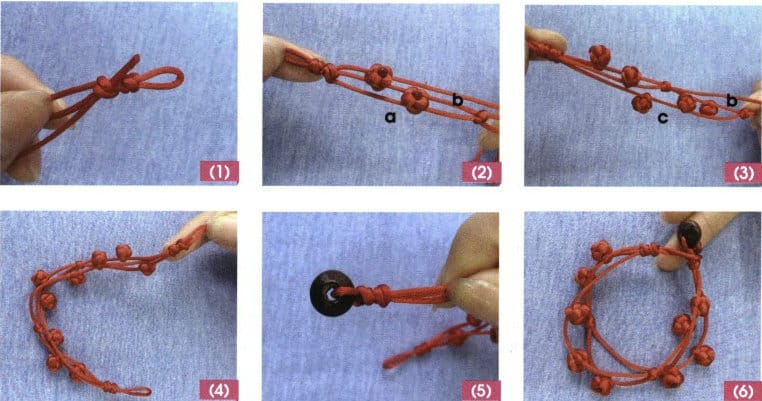
1.2 Pulseira combinada com nó de moeda dupla
(1) Caraterísticas de estilo
Esta pulseira apresenta um desenho de nó de moeda dupla no centro (semelhante a duas moedas antigas ligadas), com fio amarelo adicionado para decoração. A parte da corrente é emparelhada com nós planos, simbolizando paz, auspiciosidade e riqueza abundante, como mostra a Figura 4-4.
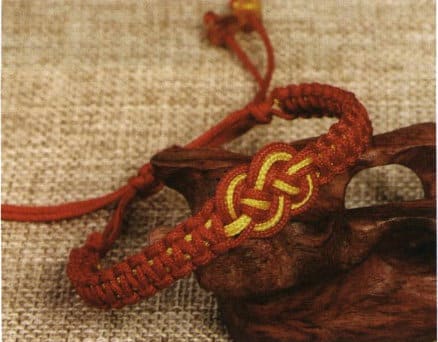
(2) Principais pontos de aprendizagem
Familiarizar-se com o método de tecer nós planos; aprender a combinação de nós planos e nós duplos e a combinação de fios coloridos.
Figura 4-4 Diagrama de estilo de pulseira com combinação de nó de moeda dupla
(3) Preparação do material
Fio vermelho: 15mm×90mm, 2 peças; 15mm×25mm, 3 peças;
Fio amarelo: 15mm×70mm, 1 peça;
Contas de concha amarelas: 6mm, 4 peças.
(4) Método de produção
① Dobrar o fio amarelo ao meio uma vez, depois dobrar novamente, determinando o ponto de um quarto; ver Figura 4-5 (1).
② Pode fazer um nó de moeda duplo com fios duplos ou atar a parte em forma de 8 de um nó de botão no ponto de um quarto (a parte inferior da armação) e, em seguida, cortar o aro de reforço para formar dois fios de nós de moeda duplos de cada lado, ver Figura 4-5 (2).
③ Pegar num fio vermelho com 25 cm de comprimento e, ao longo do trajeto do fio amarelo, tecer metade da parte "8"; ver Figura 4-5 (3).
④ Pegar noutro fio vermelho com 25 cm de comprimento e tecer a outra metade da forma de "8" ao longo do outro lado do fio amarelo, completando um círculo completo nos lados interior esquerdo e direito; ver Figura 4-5(4).
⑤ Pegar em dois fios vermelhos com 90 cm de comprimento e tecer, segundo os métodos descritos em (3) e (4), um círculo completo no exterior do fio amarelo, ajustando o tamanho dos nós, puxando bem os fios e arrumando-os bem; se for difícil tecer, pode usar uma pinça para o ajudar, ver Figura 4-5(5).
⑥ Pegue nos dois fios vermelhos mais exteriores e faça nós planos a partir do meio em direção às duas extremidades, envolvendo quatro fios (equivalente a quatro linhas de eixo). Para maior comodidade, pode fixá-lo numa placa de espuma enquanto tece os nós planos; ver Figura 4-5(6).
⑦ Depois de tecer o comprimento adequado, corte a linha do eixo central, cole-a e cruze as duas linhas da cauda utilizando um fio vermelho de 25 cm para tecer um nó plano para o selar; ver Figura 4-5(7).
⑧ Enfiar 2 contas de concha amarelas em cada extremidade, dar um nó e derreter para fixar; ver Figura 4-5 (8).

1.3 Pulseira combinada com nó de cobra
(1) Caraterísticas de estilo
Esta pulseira apresenta um nó duplo de moeda horizontal no centro, quebrando a monotonia da estrutura do nó de cobra. A utilização de fios bicolores amarelos e vermelhos realça o aspeto decorativo da peça principal, como mostra a Figura 4-6.

(2) Principais pontos de aprendizagem
Familiarizar-se com o método de produção do nó de serpente, o desenho e as técnicas de combinação do nó de dupla moeda com o nó de serpente.
(3) Preparação do material
Linha vermelha: 2,5mm×120cm, 1 peça;
Linha amarela: 2,5mm×20cm, 1 peça.
(4) Método de produção
① Fazer uma casa de botão com linha vermelha e entrançar um nó de cobra com cerca de 7 cm de comprimento; a tensão da linha deve ser adequada; ver Figura 4-7(1).
② Comece a entrançar um nó duplo de moeda a partir do centro, com o fio esquerdo a enrolar no sentido contrário ao dos ponteiros do relógio à volta de um laço; ver Figura 4-7(2).
③ Puxe a linha direita por baixo do laço para a esquerda enquanto pressiona a linha esquerda; ver Figura 4-7(3).
④ Passar a linha direita pelo laço superior por trás; ver Figura 4-7(4).
⑤ Em seguida, passe pelo laço adjacente de cima para baixo; consulte a Figura 4-7 (5).
⑥ Finalmente, passe de baixo para cima através do laço direito, que é um press and pull, e ajuste o aperto do nó duplo de moeda, ver Figura 4-7 (6).
⑦ Em seguida, continuar a tecer um nó de cobra com fio vermelho durante cerca de 7 cm e fazer um nó de botão no fim, ver Figura 4-7 (7).
⑧ Utilize o fio amarelo para começar a tecer ao longo do trajeto de um fio vermelho no nó duplo da moeda; ver Figura 4-7 (8).
⑨ Depois de completar o nó de moeda dupla, ajuste-o para um aperto adequado, corte as pontas da linha e derreta-as e cole-as na parte de trás para terminar a produção geral, ver Figura 4-7 (9).

1.4 Identifying the Braid Knot Combination Bracelet
(1) Caraterísticas de estilo
This piece is woven from a button and a braid knot. Due to the two axes supporting the knot within the braid knot, the structure is firm and dense. The button knot is like a love knot; wearing this love knot symbolizes a deep connection with a beloved person, never to be separated. See Figure 4-8.
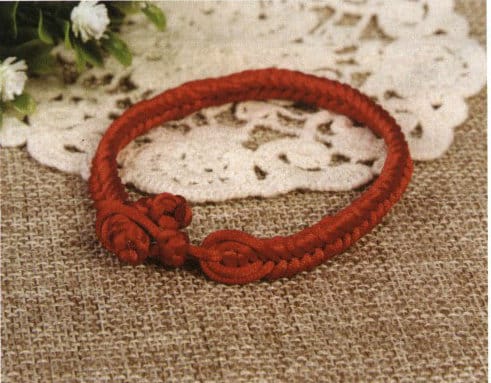
(2) Principais pontos de aprendizagem
Familiarize yourself with the weaving method of the special knot; learn the methods for adding and removing lines.
(3) Preparação do material
Red thread: 2mm× 70cm, 3 pieces; 2mm× 60cm, 1 piece.
(4) Método de produção
① Fold a 60 cm long red thread in half and tie a button knot, leaving a loop at the top (the size should be similar to that of a button knot). Set the two strands below the button knot as the axis. Place the other three strands between the axis strands and tie a double connection knot below to secure it in a cross shape; see Figure 4-9 (1).
② Use three strands of thread on each side to braid a three-strand braid, forming an overlapping cross shape; see Figure 4-9 (2).
③ Bring the left and right axis lines above the three strands of thread on each side; see Figure 4-9 (3).
④ Press the left and right lines over the axis line closest to you, then pass over the other axis line; see Figure 4-9 (4).
⑤ The lines cross between the axes, tightening them like braiding. The weaving should be tight and loose, with the lines pulled evenly; see Figure 4-9 (5).
⑥ Cut the two lines and melt the ends after weaving to the appropriate length. Tie a double connection knot and a button knot on the axis; see Figure 4-9 (6).
⑦ Then tie a button knot with the remaining two lines; see Figure 4-9 (7).

1.5 Dynamic Triple Braid Bracelet
(1) Caraterísticas de estilo
This design is based on the three-strand braid as the prototype, woven into a band with strands, creating a regular texture variation. It cleverly uses trumpet-shaped metal accessories to conceal multiple thread ends, resulting in a clean and elegant surface for the knot, as shown in Figure 4-10.
(2) Principais pontos de aprendizagem
Learn to compose single strands into a braid and apply the strands to present variations in knots; understand how trumpet-shaped accessories are used.
(3) Material Preparation (Figures 4-11)
Red thread: 1.5mm×80cm, 2 pieces;
Bell-shaped end cap: 12 mm (length) ×6mm (width), 2 pieces;
Lobster clasp: 10 mm (length) ×7mm (width), one piece;
Eye pin: 35mm, 2 pieces;
Jump ring: 6mm, 1 piece.
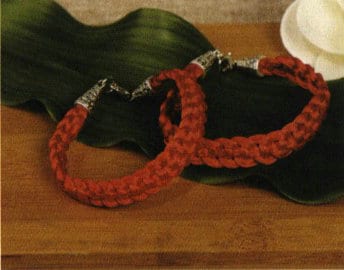
Figure 4-10 Dynamic Triple Braid Bracelet
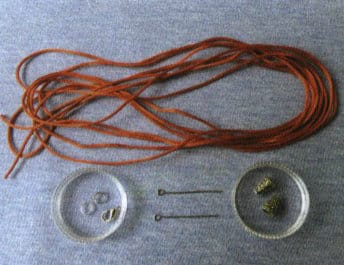
Figure 4-11 Material Preparation for Dynamic Triple Braid Bracelet
(4) Método de produção
① Fold two red threads in half, fix them at the center with a eye pin, then separate 2 strands to the left and right, as shown in Figure 4-12(1).
② Press down the right strand 1 and lift the right strand 2 to the left 2 (press one, lift one), weaving to the left side. When weaving, make sure that the two threads of each strand are flat and not overlapping, as shown in Figure 4-12(2).
③ Lift the left strand 1 and press down the right strand 1, lifting the left strand 2 (lift one, press one), weaving to the right side, as shown in Figure 4-12(3).
④ Press the right 2 strands down and pick the left 1, press the left 2 (one press, one pick), and weave to the left side, see Figure 4-12 (4).
⑤ Pick the right strand 1 down and press the right 2, press the left 2 (one pick, one press), and weave to the right side; see Figure 4-12 (5).
⑥ Following this pattern, the 2 left strands always remain in the position of the axis, providing support, while the other 3 strands are woven in a three-strand braid centered around the axis, see Figure 4-12 (6).
⑦ Finishing: Cut the two strands, melt, and bond them; see Figure 4-12 (7).
⑧ Cut the other wires separately and melt them to fix, preferably forming a gradually tapering shape so the bell-shaped end caps can cover the joint. Open the eye pin to catch the gap at the end of the wire, and then use pliers to close the eye pin, see Figure 4-12 (8).
⑨ The eye pin passes through the bell-shaped end cap and is bent into a ring shape; see Figure 4-12 (9).
⑩ Hang a lobster clasp on one side and a jump ring on the other; see Figure 4-12 (10).
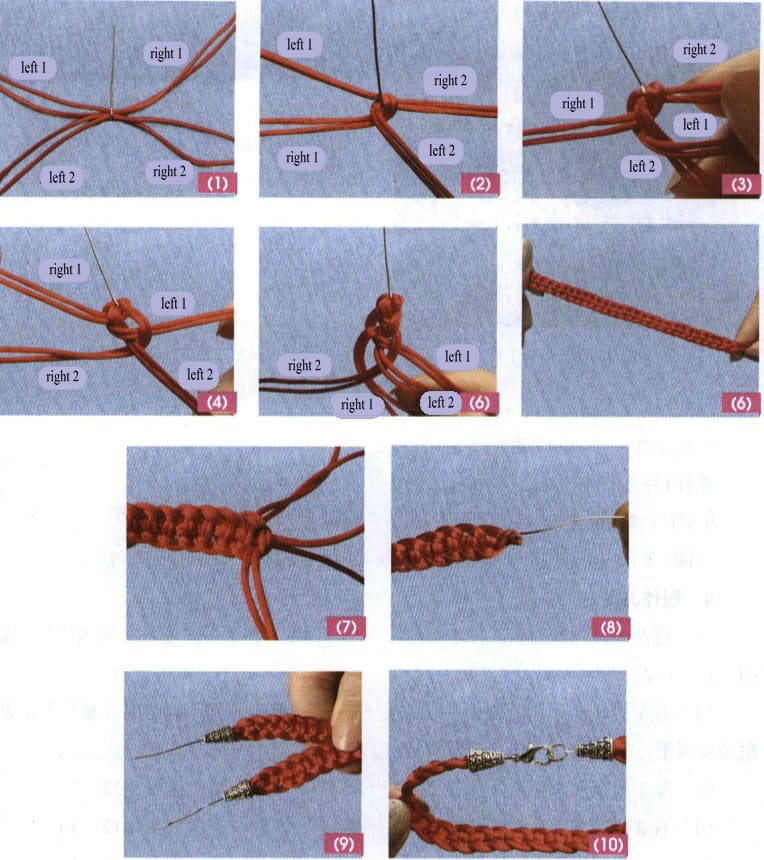
1.6 Crown Knot Bracelet
(1) Style Characteristics
This design features interwoven crown knots on the surface, alternating between left and right crown knots. The two axial lines in the middle of the knot provide support, making the structure symmetrical and dense, presenting a good three-dimensional effect, see Figure 4-13.
(2) Key Learning Characteristics
Familiarize yourself with the method of making a crown knot; master the generation of a new style through the variations of the bird’s head knot.
(3) Material Preparation (see Figure 4-14)
Dark blue threading cord: 1.5mm×80cm, 1 piece;
Light blue threading cord: 1.5mm×80cm, 1 piece;
Jade bead: 8 mm, one piece.
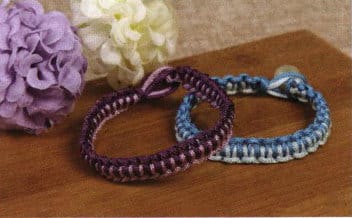
Figure 4-13 Crown knot bracelet style diagram

Figure 4-14 Crown knot bracelet material preparation
(4) Production Steps
① Fold two strands of wire in half, leaving one end 20 cm long to serve as the axis; see Figure 4-15 (1).
② Tie a double connection knot with the double strands and adjust the loops’ size so they can pass through a button; see Figure 4-15 (2)
③ Using two short strands as the axis, wrap the right strand (dark blue beading cord) from below to above around the axis to tie half of a crown knot and pull the knot tight; see Figure 4-15 (3).
④ Wrap the left strand (light blue beading cord) from below to above around the axis to tie half of a crown knot, and pull the knot tight; see Figure 4-15 (4).
⑤ The right line (dark blue beading cord) wraps around the axis from top to bottom to tie a half crown knot, together with the half knot above, a complete crown knot forms; see Figure 4-15 (5).
⑥ The right line (light blue beading cord) wraps around the axis from top to bottom and pulls tight, completing a crown knot together with the half knot above; see Figure 4-15 (6).
⑦ The left and right lines follow steps (3) to (6) to weave a crown knot to the desired length (generally 18~20cm); see Figure 4-15 (7).
⑧ Take any line from the axis to thread a jade bead and tie it securely with the other axis line; see Figure 4-15 (8).
⑨ Use the left and right threads to make a double knot under the jade bead, cut off all excess threads, and melt to secure, making the connection button tighter; see Figure 4-15 (9).
⑩ Overall effect see Figure 4-15 (10).
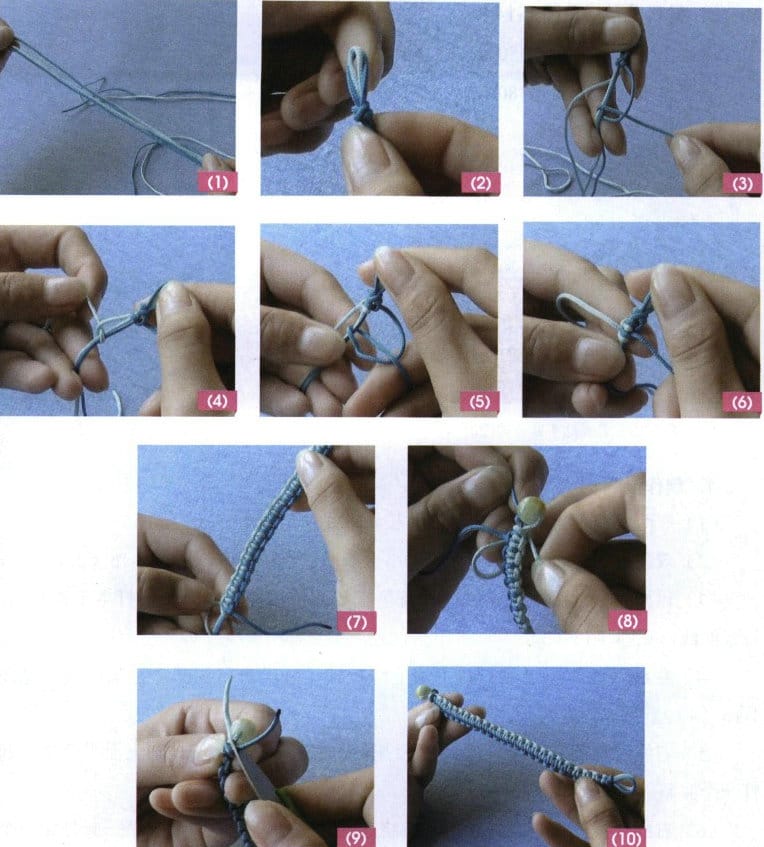
1.7 Double Snake Knot Bracelet
(1) Caraterísticas de estilo
This double snake knot, also known as the paracord knot, has a wide and thick structure, tightly woven with a strong texture effect, resembling two snakes intertwined. It is one of the very beautiful and three-dimensional knot decorations. If woven with two different thread colors, it becomes even more eye-catching. This section is more suitable for male wearers; see Figure 4-16.

(2) Principais pontos de aprendizagem
Learn the ideas and methods to combine single knots into double knots; master pulling the knot line tight and evenly.
(3) Preparação do material
Beige thread: 2.5mm×150cm, 1 piece;
Yellow thread: 2.5mm×150cm, 1 piece.
(4) Método de produção
① Fold two thread colors in half, designating one color as the axis (for example, the beige thread as the axis). Note that you should leave a loop with a diameter of about 1 cm above the axis; see Figure 4-17 (1).
② Cross the left and right threads (yellow) over the axis, see Figure 4-17 (2).
③ The axis simultaneously passes through the loop reserved on the axis and the loop formed by the yellow thread; see Figure 4-17 (3).
④ The shape after tightening all the lines is shown in Figure 4-17(4).
⑤ The right line wraps downwards around the right line axis to form a loop designated as Loop A, as shown in Figure 4-17(5).
⑥ The right axis line passes through Loop A from outside Loop A and the right line, as shown in Figure 4-17(6).
⑦ The left line presses down on the left axis line from above and passes through Loop A, as shown in Figure 4-17(7).
⑧ The left line is pulled back from behind to form loop B; see Figure 4-17 (8).
⑨ The left axis line passes through loop B from the outer side of the left line; see Figure 4-17 (9).
⑩ Tighten all lines to complete a knot, see Figure 4-17 (10).
⑪ Repeat the braiding from step (5) to step (10), see Figure 4-17 (11).
⑫ After braiding to a length suitable for the wrist, tie a button knot to finish; see Figure 4-17 (12).
⑬ Cut off the thread end, burn, and bond it to secure it; see Figure 4-17 (13).
⑭ You can see the bracelet alternating between two colors, tightly woven, resembling two intertwined snakes, with different colors and effects on both sides; see Figure 4-17 (14).


2. Beaded and Braided Bracelets Design and Production
2.1 Wooden Bead Bracelet
(1) Caraterísticas de estilo
This piece primarily uses wooden beads as the main material, paired with metal accessories. The contrast between the antique bronze metal and colorful wooden beads creates a striking effect; the cubic shape, three-dimensional pendants, and flat butterfly-like objects are mixed, showcasing a natural, rugged, and harmonious beauty, as seen in Figure 4-18.
(2) Principais pontos de aprendizagem
Learn about color and material matching knowledge to enhance the ability to combine and apply wooden beads and metal accessories.
(3) Material Preparation (Figure 4-19)
Red Wooden Beads: 10mm, 7 pieces;
Blue wooden beads: 10mm, 3 pieces;
Butterfly charm: 12mm, 3 pieces;
Metal pendant: 20 mm (length) ×10mm (width), 1 piece;
Lobster clasp: 10 mm (length) ×7mm (width), 1 piece;
Eye pin: 28mm, 9 pieces;
Jump ring: 5mm, 16 pieces.
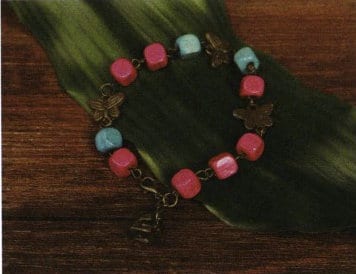
Figure 4-18 Wooden Bead Bracelet Style Diagram
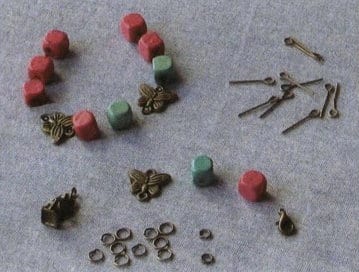
Figure 4-19 Wooden Bead Bracelet Material Preparation
(4) Método de produção
① Connect the jump ring with the eye pin, thread 1 red wooden bead onto the eye pin, and bend it into a nine shape; see Figure 4-20 (1).
② Connect the eye pin, thread 1 blue wooden bead, and bend it into a nine shape. The eye pin should be appropriate, neither too long nor too short. See Figure 4-20(2).
③ Use a jump ring to connect the butterfly charm and securely close the jump ring. See Figure 4-20(3).
④ Use a jump ring to connect each bead according to Figure 4-20 (1), and then connect it to the butterfly charm, see Figure 4-20 (4).
⑤ The connected shape is shown in Figure 4-20 (5).
⑥ Connect the metal pendant to the jump ring as a decoration; see Figure 4-20 (6).
⑦ Connect the jump ring to the lobster clasp while connecting it to the starting jump ring, making it connect end to end; see Figure 4-20 (7).

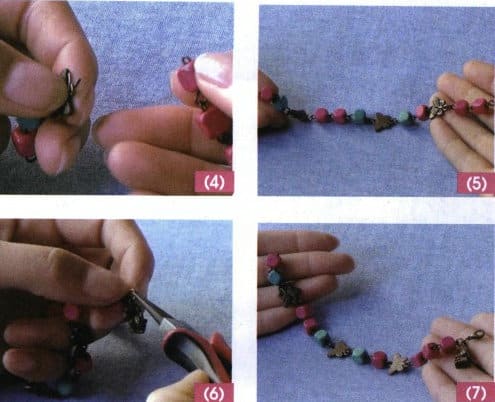
2.2 Metal Accent Bracelet
(1) Caraterísticas de estilo
This piece primarily uses metal accessories, combining thickness, color (metallic luster and bead color), and different textures (the fine details of the arc column and the ruggedness after combining floral pieces), enhancing this bracelet’s vitality. Coupled with the embellishment of small pendants, it is simple, elegant, lively, and casual, as shown in Figure 4-21.
(2) Principais pontos de aprendizagem
Learn the pairing ideas focused on metal accessories, such as combining small pieces into a whole, various shape combinations, selecting bead colors, etc.
(3) Material Preparation (Figure 4-22)
Green beads: 10mm, 2 pieces;
Metal flower spacer: 8mm, 4 pieces;
Metal plum blossom disc: 8mm, 18 pieces;
Metal fish charm: 15 mm (length) × 10 mm (width), 2 pieces;
Metal barrel spacer: 50 mm (length) × 5 mm (width), 2 pieces;
Metal three-way connector: 1 piece;
Metal ball A: 5mm, 2 pieces;
Metal ball B: 3mm, 2 pieces;
Metal gourd charm: 15 mm (length) × 5mm (width), 1 piece;
Metal coin: 15mm, 1 piece;
White transparent elastic line: 1mm, 25cm.

Figure 4-21 Metal accent bracelet style diagram
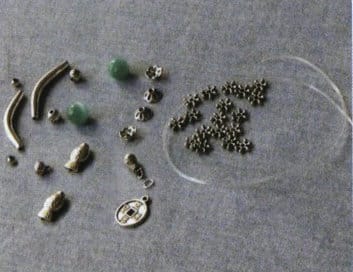
Figure 4-22 Metal accent bracelet materials
(4) Método de produção
① First, thread six metal flower pieces using the white transparent elastic line; see Figure 4-23 (1).
② Sequentially thread the metal flower spacer, green beads, metal flower spacer, 6 plum blossom disc, metal flower spacer, green beads, and metal flower spacer; see Figure 4-23 (2).
③ Thread metal ball A and metal barrel spacer on each side, see Figure 4-23 (3).
④ On one side, thread metal ball B and metal fish charm in sequence; connect metal coins and gourd charm with a jump ring to form component A; as shown in Figure 4-23 (4).
⑤ Use a metal three-way connector to hang component A on the bracelet; see Figure 4-23 (5).
⑥ On the other side, thread metal fish charm and metal ball B to make it symmetrical; see Figure 4-23 (6).
⑦ Tie a knot to secure it, cut off the excess thread, and hide the knot; the production is complete; see Figure 4-23 (7), (8), (9).

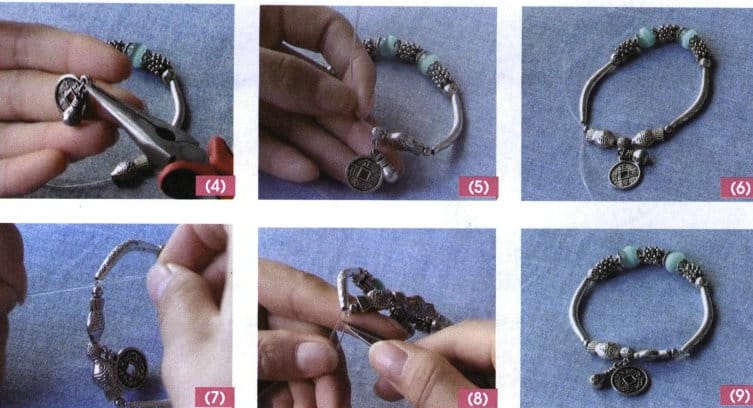
2.3 Alloy Bracelet with Colored Stones
(1) Caraterísticas de estilo
This bracelet combines green agate and vintage-style antique bronze metal accessories. The colors are retro, the textures are beautiful, and the patterns highlight an ethnic charm. Overall, it is understated, showcasing women’s intellectual elegance and delicate beauty, as seen in Figure 4-24.
(2) Principais pontos de aprendizagem
Learn about the color selection of retro-style accessories and master the methods for expressing the aesthetics of the pendant section.
(3) Material Preparation (Figure 4-25)
Green variegated stone bead A: 8mm, 2 pieces;
Green variegated stone bead B: 4 mm, 36 pieces;
Antique bronze openwork bead A: 16 mm, one piece;
Antique bronze openwork bead B: 14 mm, one piece;
Antique bronze alloy: 12mm×8mm, 9 pieces;
Brown thread: 1mm ×60cm, 1 piece.
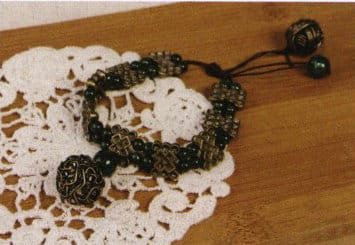
Figure 4-24 Style Diagram of Alloy Bracelet with Colored Stones
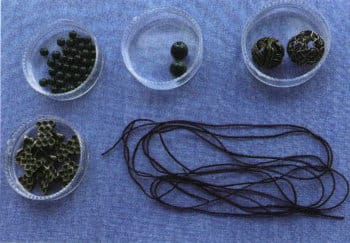
Figure 4-25 Material Preparation for Alloy Bracelet with Colored Stones
(4) Método de produção
① Fold the brown thread in half, leaving 10 cm, and make a double connection knot. Thread one green variegated stone bead B onto each upper and lower thread; see Figure 4-26 (1).
② Thread the upper and lower threads alternately through the antique bronze alloy and 2 green variegated stone beads B, see Figure 4-26 (2).
③ Repeat step (2), threading a total of 9 antique bronze alloy beads, and finally thread 1 green variegated stone bead B on each end (a total of 36 green variegated stone beads B), finish with a double connection knot to complete the chain, see Figure 4-26 (3).
④ After crossing the tail thread, tie a flat knot, thread one line through a green variegated stone bead B, and then tie a knot and melt it to secure it; as shown in Figure 4-26 (4).
⑤ Thread the other line through an antique bronze openwork bead B, tie a knot, and melt it to secure; see Figure 4-26 (5).
⑥ Thread a brown thread through the fifth antique bronze alloy bead, see Figure 4-26 (6).
⑦ After tying the money knot, thread green variegated stone bead A, then thread antique bronze openwork bead A, and tie a knot to secure it, as shown in Figure 4-26 (7).
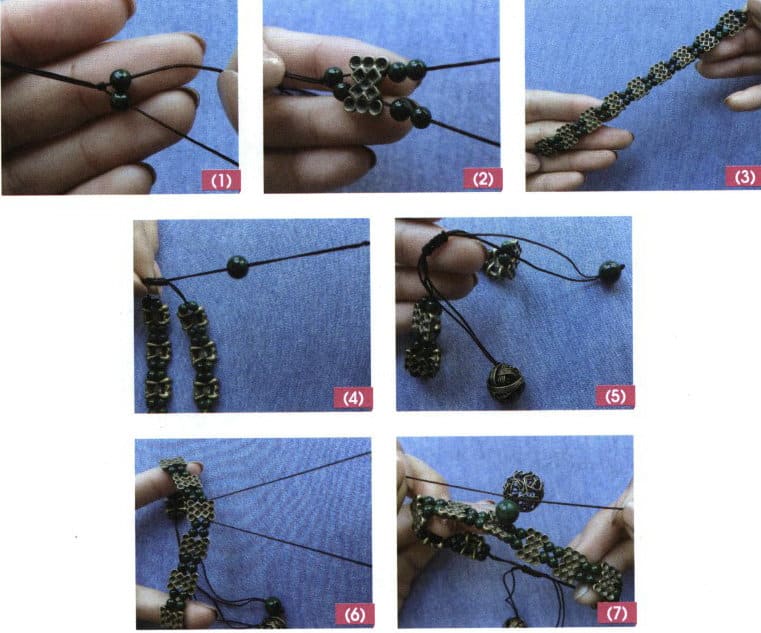
2.4 Crown Knot Beaded Bracelet
(1) Caraterísticas de estilo
This bracelet is cleverly adorned with pearls using a crown knot, resembling undulating colorful clouds. The bright pearls leap up and down on it, vivid and charming, as shown in Figure 4-27.
(2) Principais pontos de aprendizagem
I learned how to match threads and beads in color and the ideas and methods for applying the crown knot.
(3) Material Preparation (Figure 4-28)
Purple thread: 90cm×1mm, 1 piece; 30cm×1mm, 1piece;
Light blue thread: 90cm×1mm, 1 piece; 30cm×1mm, 1 piece;
Imitation Pearl A: 8cm, 4 piece;
Imitation Pearl B: 4cm, 4mm.
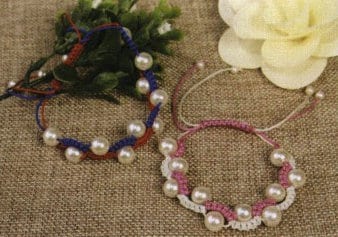
Figure 4-27 Crown Knot Beaded Bracelet Style Diagram
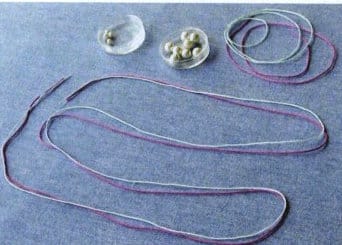
Figure 4-28 Materials Preparation for Crown Knot Beaded Bracelet
(4) Método de produção
① Take a 30 cm long light blue thread as the axis, and tie a crown knot with a 90 cm long purple thread on the axis, with the crown knots facing each other. Leave 10 cm long at the top of the 3 threads for later use; see Figure 4-29 (1).
② To avoid affecting the operations below, tie a knot with the reserved thread above and fix it to the foam pad; see Figure 4-29 (2).
③ Use light blue thread to tie 6 crown knots, ensuring the knots are uniform; see Figure 4-29 (3).
④ Use purple thread to string 1 imitation pearl A, then continue to tie 6 crown knots on the axis in the opposite direction to the crown knots tied with the light blue thread; see Figure 4-29 (4).
⑤ Use light blue thread to string 1 imitation pearl A, and continue to tie 6 crown knots on the axis; see Figure 4-29 (5).
⑥ Following the method of steps (4) to (5), alternate weaving with 2 colors of thread to create 10 imitation pearls A; see Figure 4-29 (6).
(⑦ Align the left and right tail threads and trim the excess. Cross and overlap them to serve as the axis, then take a 30 cm long purple thread to tie a flat knot for fixation, see Figure 4-29 (7).
⑧ Thread imitation pearls B onto the ends of the 4 tail threads and tie knots to secure them; see Figure 4-29 (8).
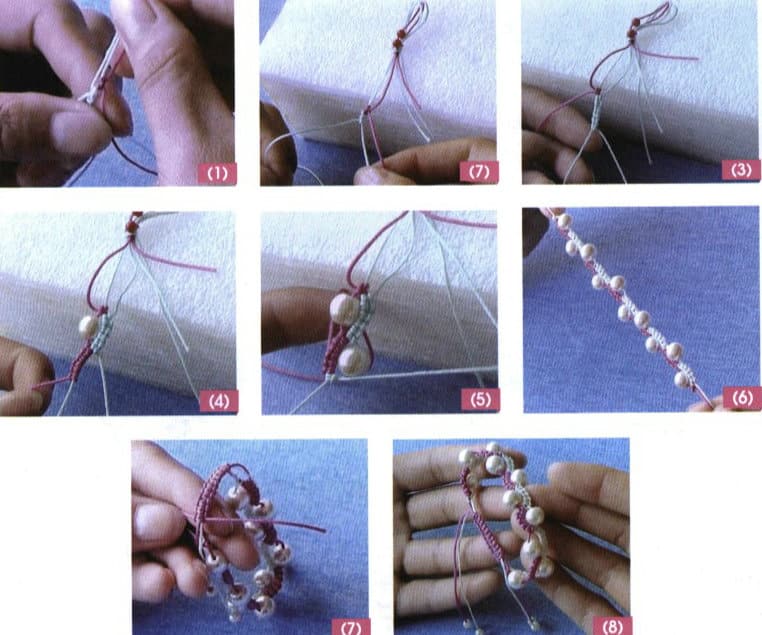
Copywrite @ Sobling.Jewelry - Fabricante de jóias personalizadas, fábrica de jóias OEM e ODM
2.5 Barrel Knot Beaded Bracelet
(1) Caraterísticas de estilo
This bracelet showcases the smooth and intricate characteristics of the barrel knot, complemented by the embellishment of white pearl seed beads. This creates variations and contrasts in volume and adds vitality and novelty to the entire bracelet, symbolizing completeness and harmony, as seen in Figure 4-30.
(2) Principais pontos de aprendizagem
Familiarize yourself with making a barrel knot; master the ideas and matching techniques of combining knots and beads.
(3) Material Preparation (see Figure 4-30)
Brown thread: 110cm×1mm, 2 pieces; 20cm×1mm, 1 piece;
Pearl seed beads: 3mm, 80 pieces (a total of 18 groups, 4 pieces + 8 pieces at the end).

Figure 4-30 Style diagram of barrel knot beaded bracelet
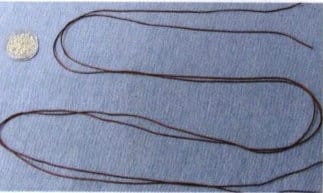
Figure 4-31 Materials preparation for barrel knot beaded bracelet
(4) Método de produção
① Fold the 110 cm long brown thread in half and leave length of 10~12cm to make a double connection knot; see Figure 4-32 (1).
② Cross another thread to make a barrel knot; see Figure 4-32 (2).
③ The length of the barrel knot should be about 3.5 cm, so make sure to pull the thread evenly and tightly. See Figure 4-32 (3).
④ Start stringing the pearls, with 1 pearl seed bead on each of the 4 strands; see Figure 4-32 (4).
⑤ Then tie a barrel knot to secure these 4 pearl seed beads; see Figure 4-32 (5).
⑥ Follow step (4)~(5) and continue to braid to about 5.5 cm long (i.e., 18 groups) as the decorative part; see Figure 4-32 (6).
⑦ Continue to braid about 3.5 cm (i.e., symmetrically) with barrel knots, then tie a double connection knot. Leave 12 cm of the 8 strands on both sides, string 1 pearl seed bead at the end of the strands, and tie a knot to secure it; see Figure 4-32 (7).
⑧ 4 groups of lines cross on each side, and another 20 cm long brown thread is used to tie a flat knot for fixation. Trim the excess thread and tie a knot to secure it; see Figure 4-32 (8).
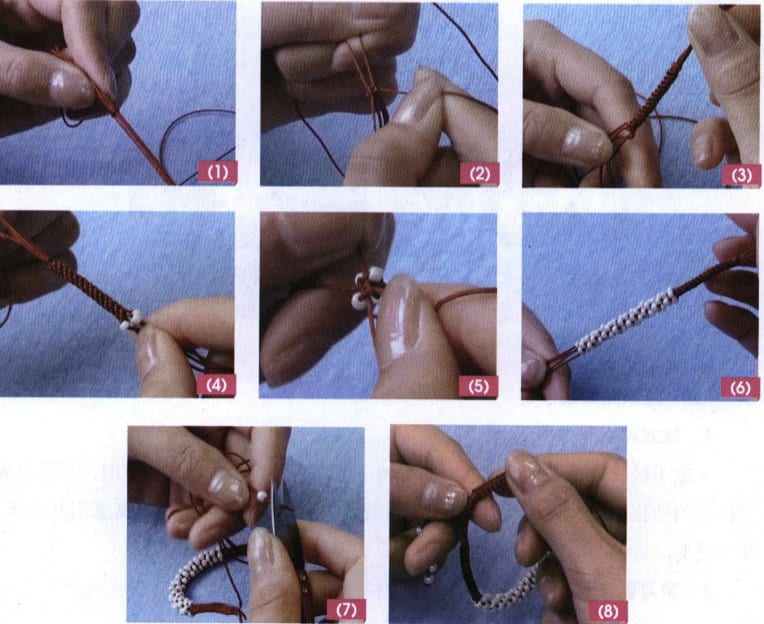
2.6 Coiled Bead Bracelet
(1) Caraterísticas de estilo
This bracelet uses wrapping thread around jade beads, creating beautiful wavy lines among the arranged beads. The red and white colors are bright and vivid, full of dynamism, see Figure 4-33.
(2) Principais pontos de aprendizagem
The method of winding threads around beads is rare, yet it has a great effect and strong decorative qualities aimed at broadening the ideas and methods of expression.
(3) Material Preparation (see Figure 4-34)
Jade Bead A: 6mm, 12 pieces;
Jade beads B: 4 mm, 4 pieces;
Red thread: 90cm×1.5mm, 1 piece.
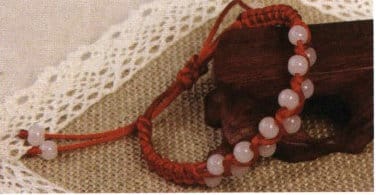
Figure 4-33 Coiled bead bracelet style
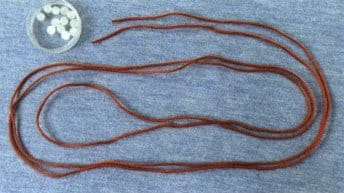
Figure 4-34 Materials preparation for a coiled bead bracelet
(4) Método de produção
① Cut a half 45 cm long red thread to serve as the axis lines a and b. Another red thread will be used for weaving, and reserve 12 cm at the beginning of the axis line to start weaving a flat knot, which is about 4 cm long. The left and right weaving threads are designated as A and B. For convenience, you can thread 6 jade beads onto lines A and B. To prevent the jade beads from falling off, you can temporarily tie a knot at the ends of lines A and B, see Figure 4-35 (1).
② Move the first jade bead on line B to the line’s base, with the left hand pressing axis line a with line A, as shown in Figure 4-35 (2).
③ Pull axis line b from underneath line B to the right side, and pull line A from underneath the jade bead on line B to the right side. Cross lines a and b, with line b on top and line a underneath, and tighten all lines, as shown in Figure 4-35 (3).
④ Move a jade bead on line A with the left hand to the root of the line; see Figure 4-35 (4).
⑤ Line B is pulled from above and under the jade bead on line A to the left, and line a is pulled from below and under the jade bead on line A to the left, tightening each line, see Figure 4-35 (5).
⑥ Line a and Line b cross on the left side, with Line a on top and Line b on the bottom, tightening each line; see Figure 4-35 (6).
⑦ Move the second jade bead on line B to the top and the root of the line; see Figure 4-35 (7).
⑧ Repeat steps (5) to (6) to finish weaving all the jade beads on both sides; see Figure 4-35 (8).
⑨ Continue to weave a flat knot equal to the initial flat knot length, thread one jade bead B onto each end of the line, and tie a knot to secure it; as shown in Figure 4-35 (9).
⑩ After crossing the left and right tail lines, weave a flat knot of about 2 cm, cut off the excess line, and melt to secure; see Figure 4-35 (10).
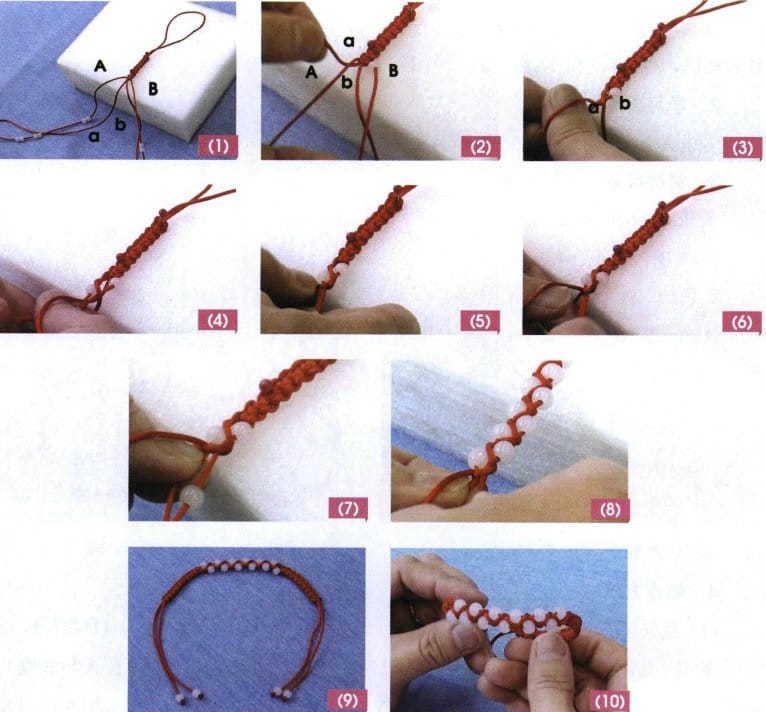
2.7 Fabric Rosette Bracelet
(1) Caraterísticas de estilo
This bracelet features a floral motif crafted from fabric rosettes, utilizing black and red agate beads for pairing. It has strong ethnic characteristics in color and style, being grand and unique, as shown in Figure 4-36.
(2) Principais pontos de aprendizagem
Learn to use fabric materials instead of wire materials, enhancing effects from the perspective of changing materials.
(3) Material Preparation (see Figure 4-37)
Red cotton fabric: 27 cm (length) ×2.1 cm (width), 6 pieces; 30 cm (length) ×2.1 cm(width), 1 piece (for making buttons); be sure to use twill; Red barrel beads: 12 mm (length) ×8 mm (width), 18 pieces;
Red agate beads A: 8mm, 1 piece;
Red agate beads B: 4mm, 16 pieces;
Red agate beads C: 2mm, 24 pieces;
Black agate beads A: 8mm, 5 pieces;
Black agate beads B: 6mm, 12 pieces;
Black agate beads C: 4mm, 16 pieces;
Black agate beads D: 2mm, 46 pieces;
Red silk thread: 100cm×1mm, 1 piece.

Figure 4-36 Style diagram of fabric rosette bracelet

Figure 4-37 Material preparation for fabric rosette bracelet
(4) Método de produção
① Making the bias strip: To facilitate the turning out the bias strip, fix a sewing thread at one end of the auspicious strip fabric with a needle; as shown in Figure 4-38 (1).
② Clamp the sewing thread inside the bias strip, and after sewing, pull the bias strip to turn it to the front side for use; see Figure 4-38 (2).
③ Fold the bias strip in half with the right sides facing each other, sew a 4 mm wide seam from the fold line, ensure the stitches are even, and be careful not to sew the thread onto the fabric, see Figure 4-38 (3).
④ Pull the thread to turn the right side of the bias strip out; see Figure 4-38 (4).
⑤ Making the petals: Cut the prepared strips into 5 pieces, each 27 cm long, and mark the midpoint to ensure symmetry. Then, starting from one end of the bias strip, roll towards the center while sewing to secure it. Use the same method to make the other end, ensuring to leave about 2 cm for the buttonhole in the middle section without rolling the edge; see Figure 4-38(5).
⑥ A total of 6 pieces are made, of which 5 are needed for the flower petals and 1 each for the buttonhole ring and button at the end of the bracelet (1 pair); see Figure 4-38 (6).
⑦ Arrange the completed components together to see if they fit. The overall diameter of the flower shape is generally controlled between 4~5cm; as shown in Figure 4-38 (7).
⑧ Fix the two ends of the rolled bias strip together. Generally, it is better to fix it on the back side and avoid exposing the thread on the front side; as shown in Figure 4-38 (8).
⑨ Then connect the petals and sew on black agate beads A as embellishments; see Figure 4-38 (9).
⑩ Finally, sew one red agate bead A in the center of the flower; see Figure 4-38 (10).
⑪ Threading the chain: First, thread the left chain, starting from one end of the buttonhole with red silk thread to string the beads, in the order of black agate bead B, (red barrel bead, black agate bead C) ×3 times, black agate bead B, and then sew it to the flower body, see Figure 4-38 (11).
⑫ Pass through a petal, continue through the middle chain, and connect to the buttonhole ring; then pass through the right chain and return to the petal; next, combine black agate bead D with red agate bead C, threading two sets of rings, ensuring that there is one petal between the two sets of rings. The method for the other side is the same, and the tail is connected to the button knot, see Figure 4-38 (12).
⑬ Finally, thread an arc-shaped chain over the two sets of rings, with the length just reaching the middle finger, making the bracelet very stable when worn, see Figure 4-38 (13).

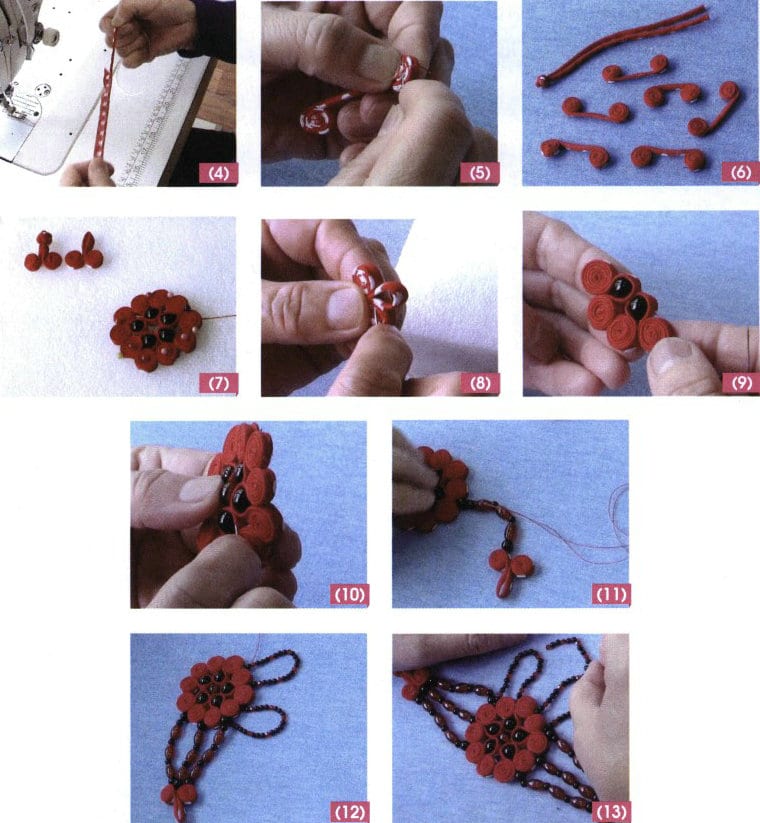
Section II Ring Design and Production
1. Five Gemstones in Bloom Ring
(1) Caraterísticas de estilo
This ring comprises five crystal beads of different sizes and shapes, with yellow seed beads forming the ring part. It clusters the beads beautifully and creates a stunning effect of five beads competing for attention, as shown in Figure 4-39.
(2) Principais pontos de aprendizagem
Learn the methods of connecting clustered beads; learn the ideas and methods for matching and combining crystal beads of different colors and shapes.
(3) Material Preparation (see Figure 4-40)
Red Faceted Crystal Beads: 8mm, 1 piece;
Purple Crystal Square Beads: 6 mm, 1 piece;
Brown Crystal Square Beads: 6mm, 1 piece;
Blue diamond beads: 6mm, 1 piece;
Green diamond beads: 6mm, 1 piece;
Yellow seed beads: 2mm, 36 pieces;
Bead head pins: 20mm, 5 pieces;
Fishing line: 3cm ×20cm, 1 strand.
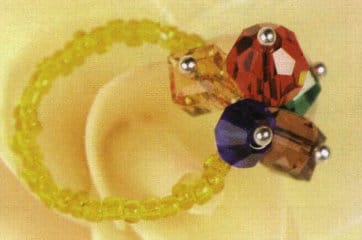
Figure 4-39 Five Gemstones in Bloom Ring Style Diagram
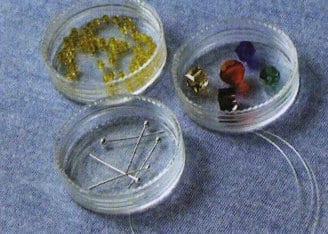
Figure 4-40 Five Gemstones in Bloom Ring Material Preparation
(4) Método de produção
① Thread the red faceted crystal bead onto the heapin, bending the other end into a figure-nine shape; see Figure 4-41 (1).
② Using the same method, thread 1 purple and 1 brown crystal square bead and 1 blue and 1 green diamond-shaped bead; see Figure 4-41 (2).
③ Use the fishing line to thread 3 yellow seed beads, then thread the figure-nine ring made of the 5 types of beads mentioned above; continue threading yellow seed beads, with the length referring to the circumference of the finger, see Figure 4-41 (3).
④ Throw the last yellow seed bead through, see Figure 4-41 (4).
⑤ Pass the fishing line through the yellow seed bead once, tie a knot at the group of 5 beads, and hide the knot; see Figure 4-41 (5).
⑥ The effect of the completed ring is shown in Figure 4-41 (6).

2. Crimson Jade Dream Ring
(1) Caraterísticas de estilo
This ring is composed of painted beads and garnet. The painted beads have a fine texture, a smooth shape, and a soft luster, accompanied by gold-edged painted spacers, resembling a dreamy red jade, with unique connotations that highlight a noble and elegant temperament, as seen in Figure 4-42.
(2) Principais pontos de aprendizagem
Familiarize yourself with the methods of stringing beads with elastic thread, tying knots, and hiding knots; master the recognition and use of materials such as painted beads and spacers.
(3) Material Preparation (see Figure 4-43)
Painted beads: 10mm, 1 piece;
Garnet beads: 3mm, 16 pieces;
Flower base: 4mm, 2 pieces;
Painted spacer: 6mm (diameter)×3mm (thickness), 2 pieces;
Metal beads: 3mm, 2 pieces;
White elastic line: 1mm×10cm, 1 piece.

Figure 4-42 Design drawing of the crimson jade dream ring
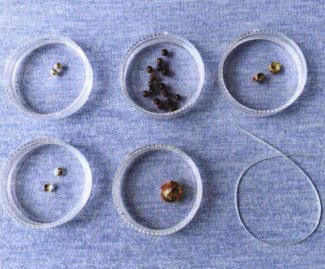
Figure 4-43 Preparation of materials for the crimson jade dream ring
(4) Método de produção
① Use white elastic thread to string 1 painted bead, flower base, painted spacer, and metal bead in sequence; see Figure 4-44 (1).
② String 16 garnet beads to make the circumference about 6 cm, see Figure 4-44 (2).
③ Continue to string the metal beads, painted spacers, and flower bases, then tie a knot here to hide it inside the large bead hole; see Figure 4-44 (3).
④ Cut off the excess thread and shape it, see Figure 4-44 (4).
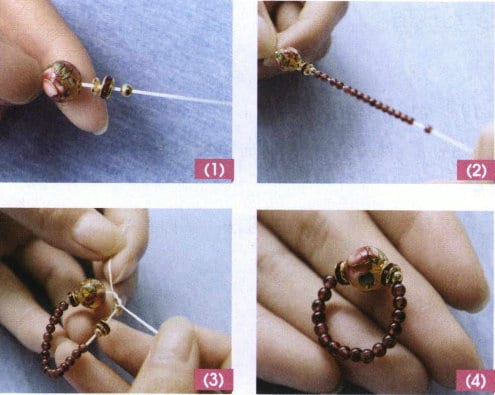
3. Velvet Rose Quartz Ring
(1) Caraterísticas de estilo
This ring is surrounded by a cluster of pink diamond-shaped crystal beads and features a large grass-green crystal bead in the center, with a ring of white pearl rice beads. The overall look is soft and round, reminiscent of a tender crystal romance that captivates and lingers in the memory, as seen in Figure 4-45.
(2) Principais pontos de aprendizagem
Familiarize yourself with threading beads to achieve a three-dimensional and prominent effect; master the combination of beads and colors.
(3) Material Preparation (Figure 4-46)
Strawberry quartz bead: 10 mm, 1 piece;
Pink diamond crystal bead: 4mm, 22 pieces;
Pearl seed bead: 2 mm, 40 pieces;
Fishing line: 50cm×3mm, 1 strand.
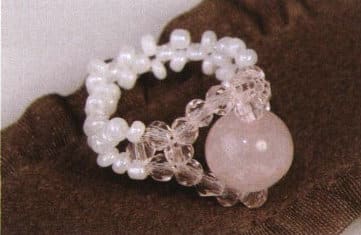
Figure 4-45 Velvet rose quartz ring style diagram
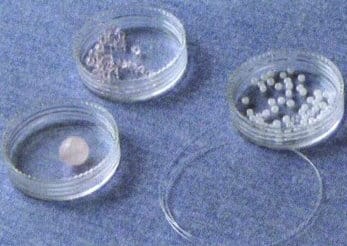
Figure 4-46 Preparation of materials for the velvet rose quartz ring
(4) Método de produção
① Main part: Use the fishing line to string 7 pearl seed beads, setting the 4th bead as the connecting A bead, and string 1 pink diamond-shaped crystal bead; see Figure 4-47 (1).
② The left and right threads each pass through 1 diamond-shaped crystal bead and thread 1 diamond-shaped crystal bead together from both sides; as shown in Figure 4-47 (2).
③ The left and right threads continue to pass through 4 crystal diamond beads and 1 strawberry quartz bead together; see Figure 4-47 (3).
④ The left and right threads each pass through 1 diamond-shaped crystal bead to enhance its three-dimensional effect; see Figure 4-47 (4).
⑤ The left and right threads pass through 3 diamond-shaped crystal beads and one diamond-shaped crystal bead together; see Figure 4-47 (5).
⑥ String 1 diamond-shaped crystal bead on each side and string 1 diamond-shaped crystal bead through the middle; then string 3 pearl seed beads on each side and 1 seed rice bead through the middle (see Figure 4-47 (6).
⑦ For the chain part, use the four-petal flower bead threading method until the desired length is reached; see Figure 4-47 (7).
⑧ Finally, cross thread the A beads together to form a ring, use the fishing line to string a few pearl seed beads back through, tie a knot, and hide the knot, see Figure 4-47 (8).
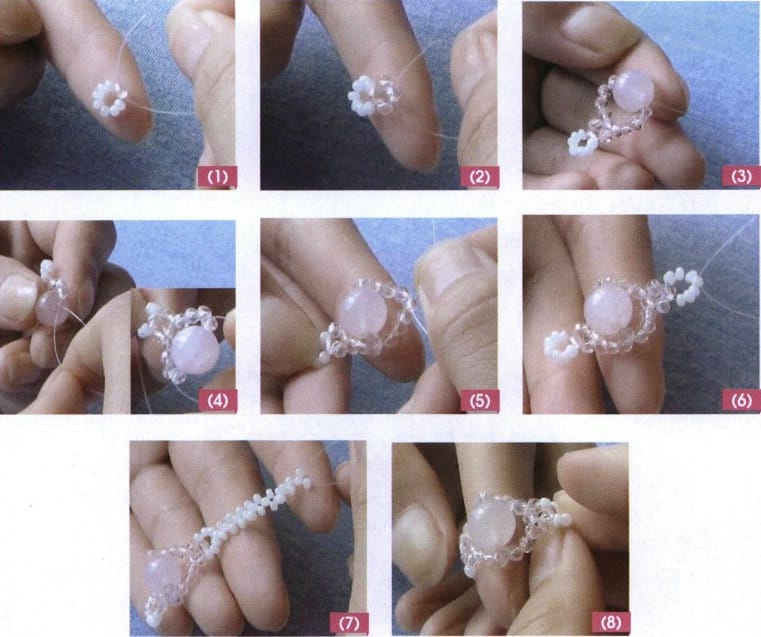
4. Plum Blossom Variations Ring
(1) Caraterísticas de estilo
This ring features three plum blossoms as the main design, surrounded by light blue seed beads forming the band, giving it a fresh and elegant overall appearance with a radiant fragrance. It resembles the three variations of the piece “Plum Blossom Variations,” harmonious and melodious. Also, it reflects the continuous story of “Plum Blossom Variations,” symbolizing a beautiful love story, see Figure 4-48.
(2) Principais pontos de aprendizagem
Learn the ideas and methods of interspersing and complementing small and large beads.
(3) Material Preparation (Figure 4-49)
Red diamond crystal beads: 5mm, 4 pieces;
Brown diamond crystal beads: 5mm, 4 pieces;
Blue diamond crystal beads: 5mm, 4 pieces;
Blue seed beads: 2mm, 44 pieces;
Yellow seed beads: 2mm, 3 pieces;
Fishing line: 2mm×50cm, 1 strand.
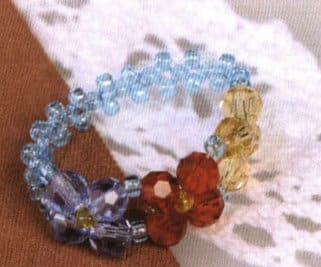
Figure 4-48 Design of the Plum Blossom Variations Ring
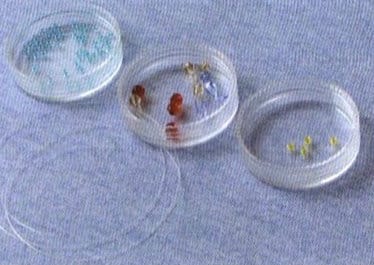
Figure 4-49 Materials Preparation for the Plum Blossom Variations Ring
(4) Método de produção
① Main Part: After folding the fishing line in half, first thread 7 blue seed beads, setting the 4th bead as Connector Bead A, then thread one brown diamond-shaped crystal bead on each side, and thread yellow seed beads through, see Figure 4-50 (1).
② Thread the brown diamond-shaped crystal beads, blue seed beads, and red diamond-shaped crystal beads onto the left and right threads in sequence, then pass through the yellow seed beads, see Figure 4-50 (2).
③ Thread the red crystal beads, blue seed beads, and blue diamond-shaped crystal beads onto the left and right threads in sequence, then pass through the yellow seed beads; then thread the blue diamond-shaped crystal beads again onto the left and right threads, see Figure 4-50 (3).
④ Thread 3 blue seed beads onto the left and right threads in sequence, then pass through the blue seed bead, see Figure 4-50 (4).
⑤ Use the four-petal flower bead threading method for the strap part until the desired length is achieved; see Figure 4-50 (5).
⑥ Finally, thread the A beads together to form a ring shape, then use the fishing line to thread a few seed beads again, tie a knot, and hide the knot, see Figure 4-50 (6).
⑦ The effect of the finished ring is shown in Figure 4-50 (7).
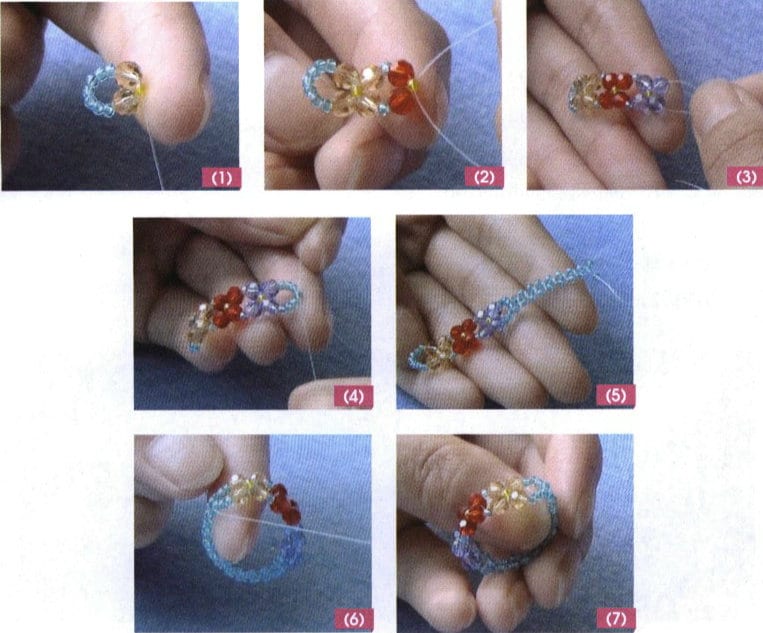
5. Scarlet Plum Blossom Ring
(1) Caraterísticas de estilo
This ring features yellow seed beads as the flower center, red crystal beads as the petals, and white transparent seed beads embedded along the outer edge of the petals, showcasing a bright plum blossom effect with a strong fragrance and a crystal-clear appearance. The overall combination is harmonious, as seen in Figure 4-51.
(2) Principais pontos de aprendizagem
Learn the methods of combining and connecting petals; try the effects of multi-color matching.
(3) Material Preparation (Figure 4-52)
Red diamond beads: 6mm, 6 pieces;
Transparent diamond beads: 3 mm, 6 pieces;
Yellow seed beads: 2mm, 12 pieces;
Transparent seed beads: 2mm, 70 pieces approximately;
Fishing line: 3mm×80cm, 1 strand.
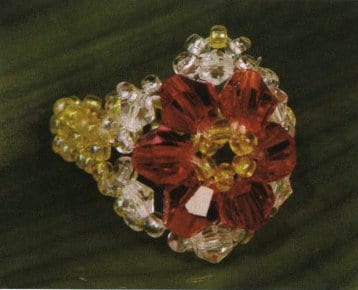
Figure 4-51 Scarlet plum blossom ring style diagram
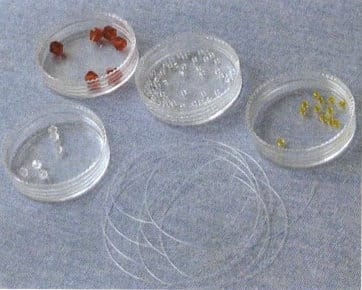
Figure 4-52 Scarlet plum blossom ring material preparation
(4) Método de produção
① Main part: Use the fishing line to string 5 yellow seed beads and pass through 1 yellow seed bead as the flower center; see Figure 4-53 (1).
② Petal 1: The right line strings a red diamond bead, a transparent seed bead, a transparent diamond bead, a transparent seed bead, a yellow seed bead, and a transparent seed bead in order, then goes back through the transparent diamond bead, see Figure 4-53 (2).
③ Petal 2: The right line strings a transparent seed bead, the left line passes through a yellow seed bead, and both lines pass through a red diamond bead, see Figure 4-53 (3).
④ Thread a transparent rice bead, a transparent diamond bead, a transparent rice bead, a yellow rice bead, and a transparent rice bead again, then go back through the transparent diamond bead; see Figure 4-53 (4).
⑤ Repeat steps (3) and (4), threading from petal 3 to petal 6, see Figure 4-53 (5).
⑥ Finishing the petals: thread a core seed bead with the left line, going through the red diamond bead of petal 1; see Figure 4-53 (6).
⑦ To secure the left and right fishing lines, repeat going back through a circle to keep the flower body flat and not curled. Finally, bring the left and right lines back to the outer edges of the two petals; see Figure 4-53 (7).
⑧ Finger ring part: the use of left and right lines were single-threaded 2 yellow seed beads and then pierced against the method of 1 yellow seed bead until the length of the finger meets the circumference of the length of the finger, see Figure 4-53 (8).
⑨ Butt the two petals symmetrically on the other side, see Figure 4-53 (9).
⑩ After threading a few more seed beads with a fishing line, tie and hide the knot, finishing the shape, see Figure 4-53 (10).

6. Rainbow Waltz Ring
(1) Caraterísticas de estilo
This ring is composed of four colors: light blue, dark blue, white, and yellow, forming multi-layered wavy curves that resemble a rainbow dancing gracefully while possessing a touch of gentleness and elegance, see Figure 4-54.
(2) Principais pontos de aprendizagem
Learn the methods and ideas for diagonal bead threading and adding beads, and master the combination of bead colors and sizes.
(3) Material Preparation (Figure 4-55)
Pearls: 4mm, 7 pieces;
Light blue seed beads: 2 mm, 14 pieces;
Dark blue seed beads: 1mm, 14 pieces;
Yellow seed beads: 2 mm, several;
Fishing line: 0.3mm×160cm, 1 strand.

Figure 4-54 Rainbow Waltz Ring Style Diagram
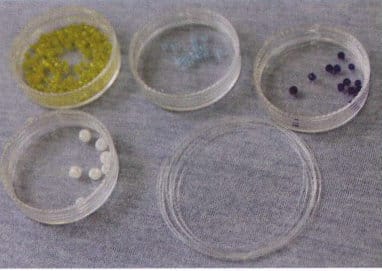
Figure 4-55 Rainbow Waltz Ring Material Preparation
(4) Método de produção
① First round: Leave 10 cm of fishing line on the left, and thread beads with the right line. String 5 yellow seed beads, designating the first bead as Bead A. Then string 2 light blue seed beads, 2 dark blue seed beads, 2 pearls, 2 dark blue seed beads, 2 light blue seed beads, and 13 yellow seed beads, see Figure 4-56(1).
② Pass through Bead A to form a circular ring; see Figure 4-56(2).
③ Second round: String 1 yellow seed bead, designating it as Bead B, then counterclockwise skip 2 yellow seed beads and pass through 1 yellow seed bead, see Figure 4-56(3).
④ String 1 yellow seed bead, then skip two beads (yellow, light blue) and pass through 1 light blue seed bead; see Figure 4-56(4).
⑤ String 1 light blue seed bead, skip one dark blue seed bead, and string 1 dark blue seed bead; see Figure 4-56 (5).
⑥ String 1 dark blue seed bead, skip 1 pearl, and string 1 pearl; see Figure 4-56 (6).
⑦ String 1 pearl, skip 1 dark blue seed bead, and string 1 dark blue seed bead; see Figure 4-56 (7).
⑧ String 1 dark blue seed bead, skip 1 dark blue seed bead, and string 1 light blue seed bead; see Figure 4-56 (8).
⑨ String 1 light blue seed bead, skip 1 yellow seed bead, and string 2 yellow seed beads; see Figure 4-56 (9).
⑩ String 1 yellow seed bead, then skip 1 yellow seed bead, string 2 light blue seed beads, and so on, until reaching bead B. The pattern is that the yellow seed bead section is skip 1, string 2; the other sections are skip 1, string 1, see Figure 4-56 (10).
⑪ Third round: Repeat the steps from the second round (5) to (10), the shaping state is shown in Figure 4-56 (11).
⑫ After completing six rounds, tie a knot, then pass through a few beads before cutting off the thread; see Figure 4-56 (12).
⑬ The overall shaping effect is shown in Figure 4-56 (13).
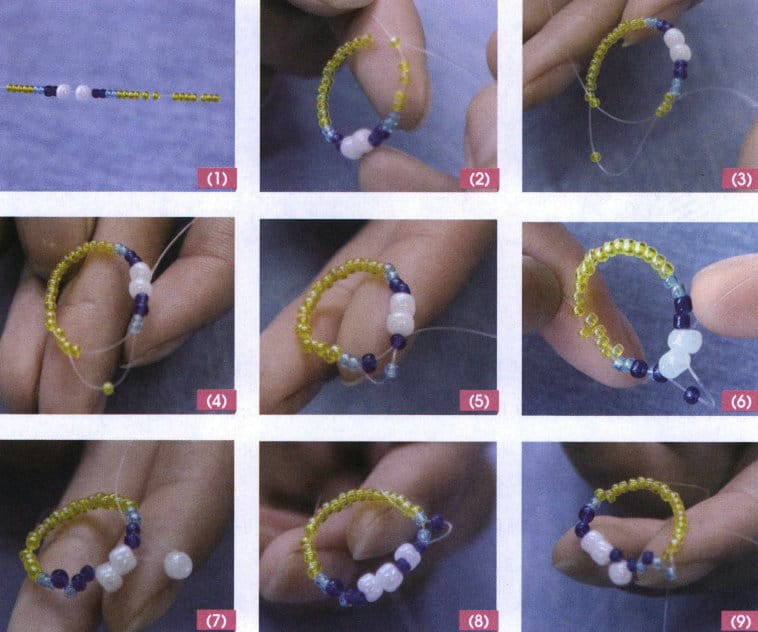

7. Golden Filigree Pearl Ring
(1) Caraterísticas de estilo
This ring is made of metal wire inlaid with agate beads, which are gentle and romantic, giving an unusual feeling to a simple design, see Figure 4-57.
(2) Principais pontos de aprendizagem
Learn to use metal wire to form various shapes and design combinations with other materials.
(3) Material Preparation (Figure 4-58)
Copper Wire A: 8mm×25cm;
Copper wire B: 3mm×40cm;
Red agate beads: 8mm, 1 piece.
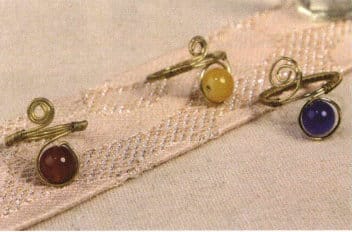
Figure 4-57 Design of a Gold Wire Inlaid Bead Ring
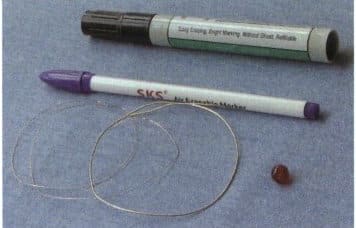
Figure 4-58 Material Preparation for Golden Filigree Pearl Ring
(4) Método de produção
① Use copper wire A to wrap around a drawing pen with a diameter of 2 cm (or a cylinder the thickness of a finger) two times to form a ring shape with a circumference equal to the size of the finger, see Figure 4-59(1).
② Wrap copper wire B around the ring on one hand to make it becomes a whole and, on the other hand, increases the decorative effect. It can be wrapped around both sides of the interface or in a circle; see Figure 4-59 (2).
③ Reserve about 4 cm of copper wire A on one side of the ring’s end and cut off the excess; see Figure 4-59 (3).
④ Use wire looping pliers to gradually roll from one end outward, forming a spiral shape; see Figure 4-59 (4).
⑤ Start rolling copper wire A on the other side of the ring’s end from the position next to the agate bead, preferably using a pen with a diameter of 0.8 cm to wrap two circles; the size of the diameter mainly depends on the size of the agate bead, see Figure 4-59 (5).
⑥ Bend the copper wire of the inner circle inward and cut the wire; see Figure 4-59 (6).
⑦ Thread the agate bead and cut off the excess material according to the diameter of the agate bead; the agate bead will be held in place by the outer copper wire and will not fall out; see Figure 4-59 (7).
⑧ Shape the ring, see Figure 4-59 (8).
